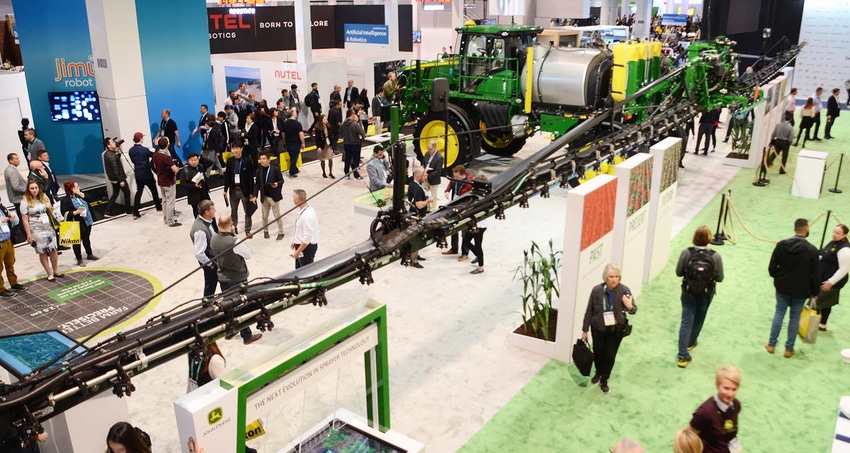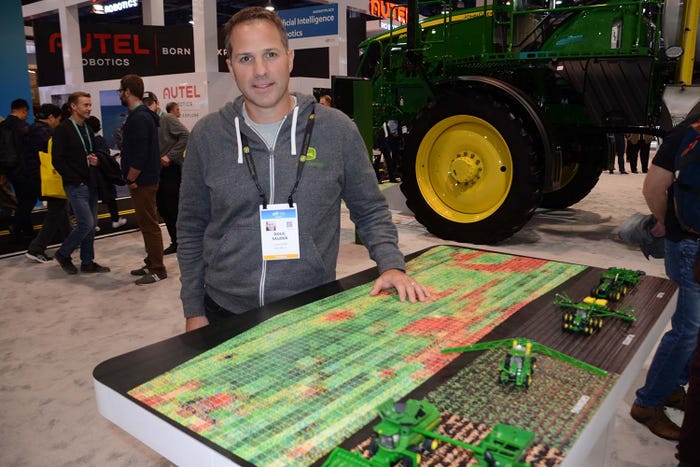January 8, 2020

There was a bit of mystery leading up to the opening of CES 2020 in Las Vegas. Mystery from John Deere about what piece of equipment would be in the exhibit at this consumer-focused show. In the company's second year at the big event, which draws thousands from around the world, the focus is really on ag.
"We wanted to connect on a deeper level, showing the practical use of ag technology in the physical world," says John Stone, senior vice president, Intelligent Solutions Group, John Deere.
The sprayer is another high-tech example of the tools farmers can use to improve their productivity. The machine features the ExactApply nozzle system, which provides individual control of each nozzle, and even can change the way each unit works to maximize that droplet heading to the crop.
"Each of those nozzles has its own computer for turning it on and off," Stone says. "And the sprayer can change how it applies based on the conditions."
He also teased a little future tech. The See and Spray technology Deere acquired when it purchased Blue River three years ago is moving to these commercial sprayers. The timeline could be as early as 2021, but testing continues. The challenge is getting that weed identification system to work "at speed" with a sprayer that can move a lot faster. But that work continues.
As for the sprayer, it's the R4038 equipped with the big 120-foot carbon-fiber boom. The show opened Tuesday, Jan. 7, and after the first day there were a couple interesting questions that came up.
"We were asked 'where do you park this?'" says Laurel Caes, public relations manager, John Deere. And there were questions about how a farmer gets the machine from field to field.
Those questions show that viewers were unaware the boom could fold – information that we all know in agriculture but shows that the consumer may 'get it' about the tech you use, but not exactly. Oh and note, the sprayer is so large it had to be in the exhibit space by Dec. 28, before most of the other exhibitors could be brought in. Being at this show is a big commitment for Deere.

LIFE CYCLE DISCUSSION: Doug Sauder, John Deere, shares that this table with toys, is designed to show the 'spatial intelligence' needed for today's farmers. The toys show each process from tillage to harvest in the life cycle of a crop. He explains that with this table, visitors can see how each step in the crop's life cycle informs the next from tillage to harvest.

Standing under the machine, Doug Sauder, director, digital product management and analytics for Deere, said he thinks of the sprayer as "a semi-autonomous robot."
He points to key challenge agriculture faces and how the autonomy built in to equipment can make a difference. "First, there's the challenge of finding available skilled labor," he says. "Second it's racing Mother Nature to get a crop in the ground and be more productive."
He noted that ultimately Deere technology should help the customer achieve profitability and sustainability, he says. The key is working to deploy technologies that make that possible.
Toy table
At the stand are two tables with John Deere toys, but there's nothing childish about the display. On each table is a tillage tool, planter, sprayer and combine/cart. Beside them is a grid of a field map.
Sauder explained that the tables are there to discuss that life-cycle of the farm, and how information should flow across each practice. It's an evolving process, but Sauder explains that each process applied should inform the next.
"The planter should know what tillage practices were carried out, the sprayer should know the crop, planting date and other information and finally the combine should know what's happened in each part of the field," he says.
Sauder explains that this level of information when applied across the farm provides "high resolution spatial intelligence." For farmers, it means knowing more and making more informed decisions through each season and building on that success year after year.
Farmers know more agricultural technology is being applied to this business. Pulling it all together for best practices and decisions comes next and Deere is showing that process at CES.
About the Author(s)
You May Also Like






